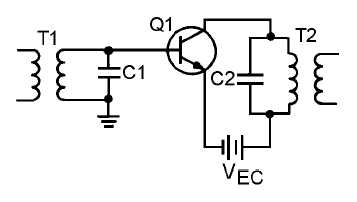2-21
happens when you select a channel on your television set or tune to a station on your radio. To
accomplish this "tuning," you need only change the value of inductance or capacitance in the parallel LC
circuits (tuned circuits).
In most cases, the capacitance is changed by the use of variable capacitors. The capacitors in the
input and output portions of all the rf amplifier stages are ganged together in order that they can all be
changed at one time with a single device, such as the tuning dial on a radio. (This technique will be shown
on a schematic a little later in this chapter.)
Q-20.
If the input-signal-developing impedance of an amplifier is increased, what is the effect on the
gain?
Q-21.
If the output impedance of an amplifier circuit is decreased, what is the effect on the gain?
Q-22.
What is the purpose of a frequency-determining network in an rf amplifier?
Q-23.
Can a parallel LC circuit be used as the frequency-determining network for an rf amplifier?
Q-24.
How can the frequency be changed in the frequency-determining network?
RF AMPLIFIER COUPLING
Figure 2-14 and the other circuits you have been shown use capacitors to couple the signal in to and
out of the circuit (C1 and C4 in figure 2-14). As you remember from chapter 1, there are also other
methods of coupling signals from one stage to another. Transformer coupling is the most common
method used to couple rf amplifiers. Transformer coupling has many advantages over RC coupling for rf
amplifiers; for example, transformer coupling uses fewer components than capacitive coupling. It can also
provide a means of increasing the gain of the stage by using a step-up transformer for voltage gain. If a
current gain is required, a step-down transformer can be used.
You should also remember that the primary and secondary windings of a transformer are inductors.
With these factors in mind, an rf amplifier could be constructed like the one shown in figure 2-15.
Figure 2-15.—Transformer-coupled rf amplifier.
In this circuit, the secondary of T1 and capacitor C1 form a tuned circuit which is the input-signal-
developing impedance. The primary of T2 and capacitor C2 are a tuned circuit which acts as the output
impedance of Q1. (Both T1 and T2 must be rf transformers in order to operate at rf frequencies.)
The input signal applied to the primary of T1 could come from the previous stage or from some input
device, such as a receiving antenna. In either case, the input device would have a capacitor connected

